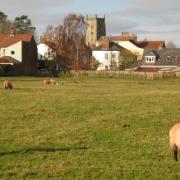There’s more to Yorkshire – and there’s certainly more to this book – than meets the eye. Review by Gordon Bennett

Even if bits of it have sometimes been cruelly annexed to suit the aspirations of politicians, Yorkshire remains Britain’s largest and best-loved county. In such a huge area, there are bound to be plenty of hidden corners, characters and mysteries waiting to be explained, and it is to these that Dr. Shipley has applied his pen.
Based largely on material from the family history of the Sharps of Ossett (liberally supplemented with details gleaned from the archives of the Yorkshire Rhubarb Council and the Tripe Marketing Board), there are many more chuckles per page than you would normally expect to find in a history book. Think 1066 And All That with a Yorkshire focus and you’ll have the measure of Forgotten Yorkshire.
Dr. Shipley’s finds are indeed remarkable: did you know, for example, that towns such as Wakefield had as many as 50 separate daily or weekly newspapers? Publishers even catered for the tiny French community living in Yorkshire during the 1920s - mainly miners, pastry chefs and furniture polishers - with separate French language daily papers a common feature on the county’s streets.
We learn how, for most of the middle ages, Hull was a member of the Hanseatic League and that they finished third in the 1471-72 season but were relegated the following year. Support for Cromwell during the early part of the English Civil War led to Hull being besieged by Royalist forces, with both sides anxious to control the city’s large arsenal. In case we didn’t already know, Dr. Shipley reminds us that the arsenal was also a member of the Hanseatic League, finishing fourth on goal difference every year for almost two centuries.
There may also be people in the north Leeds suburbs of Bramley and Moortown who have already forgotten quite how influential the Moortown Sound was, but Dr. Shipley explains its finer touches - such as the sound of clog-dancing to accentuate the back beat, the use of a tuba rather than a bass guitar and a call-and-response singing style that had its origins in the sheepdog trials that take place annually on the moors high above Leeds. At one point, the Bramley Moortown label managed to hold every one of the Top Ten slots in the East Yorkshire Musical Express Pop 30 Chart - quite a feat for a Leeds-based studio.
But it is when he turns his attention to the age-old question ‘Was God a Yorkshireman?’ that Dr. Shipley really comes into his own. He takes us on a journey deep into North Yorkshire, following in the footsteps of the noted pseudo-scientist Erich von Kruppenheim. His findings will amaze you.
Forgotten Yorkshire and Parts of North Derbyshire and Humberside deserves to turn up in a lot of people’s stockings this Christmas. If it does, there’ll be laughter guaranteed in the household. This is an astounding book for people who want to celebrate Yorkshire’s proud history, whether that of its writers, its scientists, its towns or its landscape gardeners. As you read it, you’ll wonder how on earth you ever forgot some of the ‘facts’, tall stories and tales included. You may need a strong drink to swallow them. I suspect that Dr. Shipley had one or two while writing them.
Forgotten Yorkshire and Parts of North Derbyshire and Humberside by Dr Eric. K. Shipley is published by TMB Books and costs £9.99



























